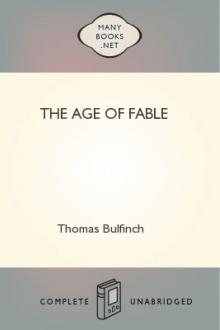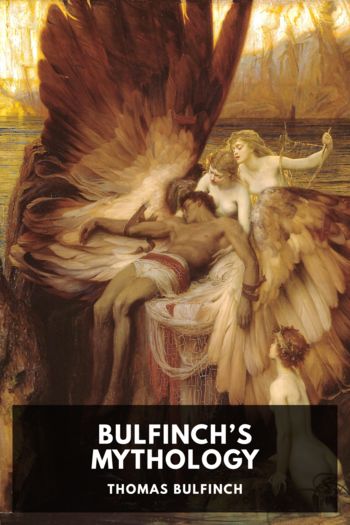The Age of Fable, Thomas Bulfinch [mini ebook reader TXT] 📗

- Author: Thomas Bulfinch
- Performer: -
Book online «The Age of Fable, Thomas Bulfinch [mini ebook reader TXT] 📗». Author Thomas Bulfinch
The four sons of Brahma, so significantly brought into the world, became the fathers of the human race, and heads of their respective castes. They were commanded to regard the four Vedas as containing all the rules of their faith, and all that was necessary to guide them in their religious ceremonies. They were also commanded to take rank in the order of their birth, the Brahmans uppermost, as having sprung from the head of Brahma.
A strong line of demarcation is drawn between the first three castes and the Sudras. The former are allowed to receive instruction from the Vedas, which is not permitted to the Sudras. The Brahmans possess the privilege of teaching the Vedas, and were in former times in exclusive possession of all knowledge. Though the sovereign of the country was chosen from the Shatriya class, also called Rajputs, the Brahmans possessed the real power, and were the royal counsellors, the judges and magistrates of the country; their persons and property were inviolable; and though they committed the greatest crimes, they could only be banished from the kingdom. They were to be treated by sovereigns with the greatest respect, for “a Brahman, whether learned or ignorant, is a powerful divinity.”
When the Brahman arrives at years of maturity it becomes his duty to marry. He ought to be supported by the contributions of the rich, and not to be obliged to gain his subsistence by any laborious or productive occupation. But as all the Brahmans could not be maintained by the working classes of the community, it was found necessary to allow them to engage in productive employments.
We need say little of the two intermediate classes, whose rank and privileges may be readily inferred from their occupations. The Sudras or fourth class are bound to servile attendance on the higher classes, especially the Brahmans, but they may follow mechanical occupations and practical arts, as painting and writing, or become traders or husbandmen. Consequently they sometimes grow rich, and it will also sometimes happen that Brahmans become poor. That fact works its usual consequence, and rich Sudras sometimes employ poor Brahmans in menial occupations.
There is another class lower even than the Sudras, for it is not one of the original pure classes, but springs from an unauthorized union of individuals of different castes. These are the Pariahs, who are employed in the lowest services and treated with the utmost severity. They are compelled to do what no one else can do without pollution. They are not only considered unclean themselves, but they render unclean everything they touch. They are deprived of all civil rights, and stigmatized by particular laws regulating their mode of life, their houses, and their furniture. They are not allowed to visit the pagodas or temples of the other castes, but have their own pagodas and religious exercises. They are not suffered to enter the houses of the other castes; if it is done incautiously or from necessity, the place must be purified by religious ceremonies. They must not appear at public markets, and are confined to the use of particular wells, which they are obliged to surround with bones of animals, to warn others against using them. They dwell in miserable hovels, distant from cities and villages, and are under no restrictions in regard to food, which last is not a privilege, but a mark of ignominy, as if they were so degraded that nothing could pollute them. The three higher castes are prohibited entirely the use of flesh. The fourth is allowed to use all kinds except beef, but only the lowest caste is allowed every kind of food without restriction.
BUDDHA
Buddha, whom the Vedas represent as a delusive incarnation of Vishnu, is said by his followers to have been a mortal sage, whose name was Gautama, called also by the complimentary epithets of Sakyasinha, the Lion, and Buddha, the Sage.
By a comparison of the various epochs assigned to his birth, it is inferred that he lived about one thousand years before Christ.
He was the son of a king; and when in conformity to the usage of the country he was, a few days after his birth, presented before the altar of a deity, the image is said to have inclined its head as a presage of the future greatness of the new-born prophet. The child soon developed faculties of the first order, and became equally distinguished by the uncommon beauty of his person. No sooner had he grown to years of maturity than he began to reflect deeply on the depravity and misery of mankind, and he conceived the idea of retiring from society and devoting himself to meditation. His father in vain opposed this design. Buddha escaped the vigilance of his guards, and having found a secure retreat, lived for six years undisturbed in his devout contemplations. At the expiration of that period he came forward at Benares as a religious teacher. At first some who heard him doubted of the soundness of his mind; but his doctrines soon gained credit, and were propagated so rapidly that Buddha himself lived to see them spread all over India. He died at the age of eighty years.
The Buddhists reject entirely the authority of the Vedas, and the religious observances prescribed in them and kept by the Hindus. They also reject the distinction of castes, and prohibit all bloody sacrifices, and allow animal food. Their priests are chosen from all classes; they are expected to procure their maintenance by perambulation and begging, and among other things it is their duty to endeavor to turn to some use things thrown aside as useless by others, and to discover the medicinal power of plants. But in Ceylon three orders of priests are recognized; those of the highest order are usually men of high birth and learning, and are supported at the principal temples, most of which have been richly endowed by the former monarchs of the country.
For several centuries after the appearance of Buddha, his sect seems to have been tolerated by the Brahmans, and Buddhism appears to have penetrated the peninsula of Hindustan in every direction, and to have been carried to Ceylon, and to the eastern peninsula. But afterwards it had to endure in India a long-continued persecution, which ultimately had the effect of entirely abolishing it in the country where it had originated, but to scatter it widely over adjacent countries. Buddhism appears to have been introduced into China about the year 65 of our era. From China it was subsequently extended to Corea, Japan, and Java.
THE GRAND LAMA
It is a doctrine alike of the Brahminical Hindus and of the Buddhist sect that the confinement of the human soul, an emanation of the divine spirit, in a human body, is a state of misery, and the consequence of frailties and sins committed during former existences. But they hold that some few individuals have appeared on this earth from time to time, not under the necessity of terrestrial existence, but who voluntarily descended to the earth to promote the welfare of mankind. These individuals have gradually assumed the character of reappearances of Buddha himself, in which capacity the line is continued till the present day, in the several Lamas of Thibet, China, and other countries where Buddhism prevails. In consequence of the victories of Gengis Khan and his successors, the Lama residing in Thibet was raised to the dignity of chief pontiff of the sect. A separate province was assigned to him as his own territory, and besides his spiritual dignity he became to a limited extent a temporal monarch. He is styled the Dalai Lama.
The first Christian missionaries who proceeded to Thibet were surprised to find there in the heart of Asia a pontifical court and several other ecclesiastical institutions resembling those of the Roman Catholic church. They found convents for priests and nuns; also processions and forms of religious worship, attended with much pomp and splendor; and many were induced by these similarities to consider Lamaism as a sort of degenerated Christianity. It is not improbable that the Lamas derived some of these practices from the Nestorian Christians, who were settled in Tartary when Buddhism was introduced into Thibet.
PRESTER JOHN
An early account, communicated probably by travelling merchants, of a Lama or spiritual chief among the Tartars, seems to have occasioned in Europe the report of a Presbyter or Prester John, a Christian pontiff resident in Upper Asia. The Pope sent a mission in search of him, as did also Louis IX. of France, some years later, but both missions were unsuccessful, though the small communities of Nestorian Christians, which they did find, served to keep up the belief in Europe that such a personage did exist somewhere in the East. At last in the fifteenth century, a Portuguese traveller, Pedro Covilham, happening to hear that there was a Christian prince in the country of the Abessines (Abyssinia), not far from the Red Sea, concluded that this must be the true Prester John. He accordingly went thither, and penetrated to the court of the king, whom he calls Negus. Milton alludes to him in “Paradise Lost,” Book XI., where, describing Adam’s vision of his descendants in their various nations and cities, scattered over the face of the earth, he says,—
“… Nor did his eyes not ken Th’ empire of Negus, to his utmost port, Ercoco, and the less maritime kings, Mombaza and Quiloa and Melind.”
NORTHERN MYTHOLOGY
The stories which have engaged our attention thus far relate to the mythology of southern regions. But there is another branch of ancient superstitions which ought not to be entirely overlooked, especially as it belongs to the nations from which we, through our English ancestors, derive our origin. It is that of the northern nations, called Scandinavians, who inhabited the countries now known as Sweden, Denmark, Norway, and Iceland. These mythological records are contained in two collections called the Eddas, of which the oldest is in poetry and dates back to the year 1056, the more modern or prose Edda being of the date of 1640.
According to the Eddas there was once no heaven above nor earth beneath, but only a bottomless deep, and a world of mist in which flowed a fountain. Twelve rivers issued from this fountain, and when they had flowed far from their source, they froze into ice, and one layer accumulating over another, the great deep was filled up.
Southward from the world of mist was the world of light. From this flowed a warm wind upon the ice and melted it. The vapors rose in the air and formed clouds, from which sprang Ymir, the Frost giant and his progeny, and the cow Audhumbla, whose milk afforded nourishment and food to the giant. The cow got nourishment by licking the hoar frost and salt from the ice. While she was one day licking the salt stones there appeared at first the hair of a man, on the second day the whole head, and on the third the entire form endowed with beauty, agility, and power. This new being was a god, from whom and his wife, a daughter of the giant race, sprang the three brothers Odin, Vili, and Ve. They slew the giant Ymir, and out of his body formed the earth, of his blood the seas, of his bones the mountains, of his hair the trees, of his skull the heavens, and of his brain clouds, charged





Comments (0)